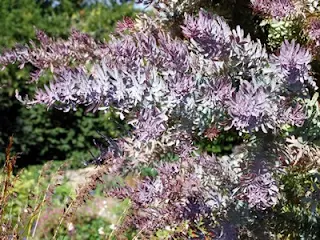On the topic of favorite plants there are so many to choose from even if you deal with local ones you see all the time. When I was taking landscape architecture/design in college it was a lot of fun because we would go on walks around campus and use what was planted there for one semester and then we would go to Balboa Park for the other two semesters.
One of my favorite trees I learned about is called Acacia Baileyana 'pupurea'.
The original variety has wonderful blue grey/green fern looking foliage which is pretty in it's own right but purpurea is even better. The new growth and flower branches, as well as some of the leaves, have a light purple tinge to them. Hard to see in this photo so will have to find it online.
 |
| Good shot of the new growth in full sun. |
It just makes me smile seeing it and oddly enough it was in the parking lot of a Costco in Santee (next town over).
I don't know why I'm attracted to this variety but maybe it's because it's so unusual as a tree and the colors are in my favorite range.
Acacias as some many know are very tough and a good portion of them come from Africa. They are actually in the bean family and it's obvious when you see the seed pods in the late spring/early summer.
There are hundreds of varieties and the feathery foliage is actually their most common form. Several varieties new growth starts ferny and feathery looking then shifts to a solid leaf and others form a winged stem that essentially acts like a leaf. This one keeps the blue tinged ferny leaves and has the bonus of purple new growth and flower buds. It makes it look delicate but it isn't.
Extremely drought tolerant, fast growing (double or triple it's size in three years), this particular variety doesn't offer much shade but given enough room can get up to 20 feet tall and wide. Once established (more on that later) they need almost no water on the coast and just occasional water inland. By occasional I mean a light watering maybe once a month if it's really hot. Almost all acacias have the same type of flowers, small puffballs of yellow to cream that have a lot of pollen. A lot of people are allergic to them which is a sad state of affairs when you're dealing with such a gorgeous color specimen as this one.
Just a little plant geek squee when I saw it in the parking lot and had to take a picture or two. The plants planted around the base are yellow gazanias, another tough groundcover and it echoes the yellow of the flowers.
So about that term, 'when established'. Technically it means when the roots have grown out of the confines of the original rootball and are taking in nutrients and water from the surrounding area. That can vary greatly depending on the plant. Faster growing plants it can be in a few months (like tomatoes) or in the case of larger trees, could take up to a year or more. Fast growing trees like the acacia can be established within a year or so.
 |
| Phoenix canariensis, man for scale |






No comments:
Post a Comment
Questions? Comments, Concerns...